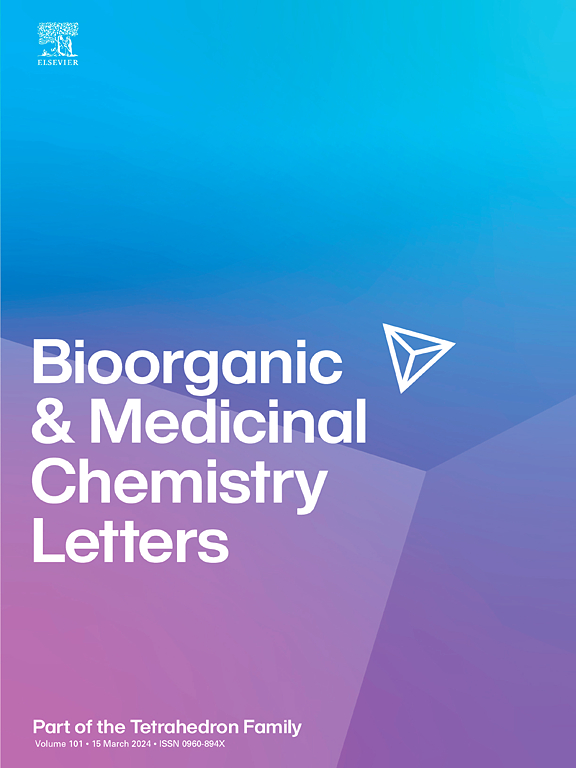2-氯-5-(乙基-苯基-磺胺基)- n-[2-(2-氧基-吡咯烷-1-基)-苯基]-苯酰胺的结构导向修饰,以获得细小隐孢子虫n-肉豆醇基转移酶的选择性抑制剂。
IF 2.5
4区 医学
Q3 CHEMISTRY, MEDICINAL
引用次数: 0
摘要
小隐孢子虫是一种引起儿童严重腹泻疾病的原生动物寄生虫,每年有近5万名5岁以下儿童死于该疾病。尽管付出了巨大的研究努力,但仍然缺乏有效的治疗方法和疫苗。新型的抗n -肉豆蔻酰基转移酶(CpNMT)抑制剂是开发有效治疗方法的潜在起点。为了寻找有前途的选择性CpNMT抑制剂,对化合物1(2-氯-5-(乙基-苯基-磺胺基)- n-[2-(2-氧基-吡咯烷-1-基)-苯基]-苯酰胺)进行了结构指导修饰。所得到的化合物对宿主酶HsNMT1的选择性抑制作用进行了评估。化合物11e和11f具有良好的抑制作用,IC50值分别为2.5和2.8 μM。虽然11e对CpNMT的选择性略高于人类NMT1(约5倍),但化合物11f的选择性为40倍,验证了我们基于结构的设计方法。化合物11e和11f对小孢子虫生长也有抑制作用,EC50值分别为6.9 μM和16.4 μM 。本文章由计算机程序翻译,如有差异,请以英文原文为准。
![Structure guided modification of 2-chloro-5-(ethyl-phenyl-sulfamoyl)-N-[2-(2-oxo-pyrrolidin-1-yl)-phenyl]-benzamide to afford selective inhibitors of Cryptosporidium parvum N-myristoyltransferase](https://img.booksci.cn/booksciimg/2025-1/99296542331768702088.jpg)
Structure guided modification of 2-chloro-5-(ethyl-phenyl-sulfamoyl)-N-[2-(2-oxo-pyrrolidin-1-yl)-phenyl]-benzamide to afford selective inhibitors of Cryptosporidium parvum N-myristoyltransferase
Cryptosporidium parvum is a protozoan parasite that causes severe diarrheal illness in children and each year nearly 50,000 children under age 5 die due to the disease. Despite tremendous research efforts, there remains a lack of effective therapies and vaccines. Novel inhibitors against N-myristoyltransferase of C. parvum (CpNMT) are potential starting points towards the development of effective therapies. In quest of promising selective CpNMT inhibitors, structure guided modifications of compound 1 (2-chloro-5-(ethyl-phenyl-sulfamoyl)-N-[2-(2-oxo-pyrrolidin-1-yl)-phenyl]-benzamide) were performed. The resulting compounds were evaluated for selective inhibition of CpNMT over the host enzyme HsNMT1. Compounds 11e and 11f exhibited good inhibition, with IC50 values of 2.5 and 2.8 μM, respectively. While 11e was slightly more selective towards CpNMT over HsNMT1 (∼5-fold), compound 11f showed >40-fold selectivity, validating our structure-based design approaches. Compounds 11e and 11f were also found to be efficacious against C. parvum growth, with EC50 values of 6.9 and 16.4 μM, respectively.
求助全文
通过发布文献求助,成功后即可免费获取论文全文。
去求助
来源期刊
CiteScore
5.70
自引率
3.70%
发文量
463
审稿时长
27 days
期刊介绍:
Bioorganic & Medicinal Chemistry Letters presents preliminary experimental or theoretical research results of outstanding significance and timeliness on all aspects of science at the interface of chemistry and biology and on major advances in drug design and development. The journal publishes articles in the form of communications reporting experimental or theoretical results of special interest, and strives to provide maximum dissemination to a large, international audience.

 求助内容:
求助内容: 应助结果提醒方式:
应助结果提醒方式:


